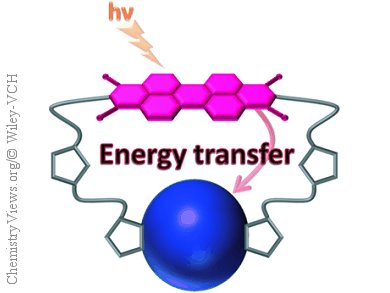Although C60 derivatives, in particular [6,6]phenyl-C61-butyric acid methyl ester (PCBM), are a key component for developing highly efficient bulk heterojunction solar cells (BHJSCs). However, they suffer from poor absorption in the visible region. For a widening of the solar spectrum coverage and an improvement of the absorption efficiencies, C60 derivatives are often coupled with dyes that act as light-harvesting antennae.
Fullerene bisadducts are promising electron-accepting materials because of the increased open-circuit voltage of BHJSCs based on these compounds compared with those based on PCBM. That led Angela Sastre-Santos, Universidad Miguel Hernández de Elche, Alicante, Spain, and co-workers to synthetize C60 bisadducts connected with the strong absorber perylenediimide (PDI) in a cyclic fashion.
A double click reaction plus a double Prato reaction afforded the C60-PDI dyads. A fast energy transfer rate was obtained by Shunichi Fukuzumi, Osaka University, Japan, and co-workers for PDICl4-C60 systems. This result and the enhancement of molar absorption coefficient by PDI anchorage will be highly valuable for the use of PDICl4-C60 systems as acceptors in BHJSCs.
- Macrocyclic Dyads Based on C60 and Perylenediimides Connected by Click Chemistry,
Sara Pla, Luis Martín-Gomis, Kei Ohkubo, Shunichi Fukuzumi, Fernando Fernández-Lázaro, Ángela Sastre-Santos,
Asian J. Org. Chem. 2014.
DOI: 10.1002/ajoc.201300235



